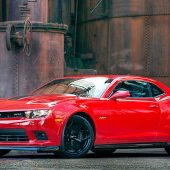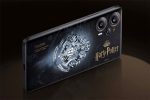The third generation Camaro was launched in the fall of 1981 as an ‘82 model. The all new body styling was futuristic. The body now featured “hatch” styling rather than a traditional trunk. Models included the Sport Coupe, Berlinetta, and Z28. For the first time in Camaro history, a 4-cylinder engine was available in the sport coupe. The 3-speed manual transmission disappeared leaving the base transmission as a 4-speed manual. Third-generation Camaros were the first built without front subframes or leaf-spring rear suspensions. Now the front end was held up with a modified MacPherson strut system, and at the rear there was a long torque arm and coil springs.
The 1982 engine selection started with a 90 horsepower version of GM’s 2.5-liter “Iron Duke” four and could be optioned up to a 112 hp 2.8-litre V6 (base engine in the Berlinetta) or a four-barrel carbureted 5.0-litre (305-cubic-inch) small-block V8 rated at 145 horsepower. That V8 was the Z28’s base powerplant. Buyers could opt for a Z28 “Cross-Fire Injection” (throttle body-injected) version producing 165 horsepower. The carbureted V8 could be had with either a three-speed automatic or four-speed manual, but the injected engine was automatic only.
In 1985 the IROC-Z hit the streets. IROC sport equipment package (named after the International Race of Champions) was an option to the Z28 model. IROC featured big 16-inch five-spoke wheels and unique graphics. Carbureted versions of the 5.0-litre small-block V8 were still available, but the most significant change came with the fitment of Tuned Port Injection (TPI) to that engine to produce a flexible 215 horsepower. The TPI engine was only available with the four-speed automatic (in either the IROC or the regular Z28). On all models, new air dams, grilles, front fascias parking lamps and tail lamps were new. Also the interior fabrics and colour were revised.
Big engines returned to the Camaro for 1987 with the 350 (5.7-litre) V8 making its way into IROC-Zs as an option. With the TPI system, the 5.7-litre was rated at 225 horsepower. In the Camaro, the 5.7-litre engine’s heads and exhaust manifolds were made of iron, instead of aluminum and stainless steel used in the Corvette. The convertible model returned for the 1987 model year for the first time since 1969. Convertibles could be ordered as base, Type LT (which, incidentally, replaced the Berlinetta model), Z28 or IROC.
By 1988, Chevy had firmly established the IROC name, so all high-performance ’88 Camaros became IROCs. While all Camaros offered 15 inch wheels, a 16 inch wheel option was offered on IROC Z models. The sport coupe model received the Z28 style fascia from the previous year. The 5.7-litre engine received more horsepower and was now rated at 230hp. The rarest and most intriguing Camaro was the 1LE road racing package optional on the IROCs with both the 5.0- and 5.7-litre TPI engines. The 1LE featured oversize disc brakes, an aluminum driveshaft and a well-tweaked suspension
1990 was the last model year for the IROC as Dodge picked up sponsorship of the International Race of Champions. The V6 engine was increased in size from 2.8 to 3.1 litres. It also gained additional horsepower and rated now 140 hp. All 1990 Camaros received a driver’s side airbag along with standard tilt wheel, tinted glass, intermittent wipers, and halogen headlamps. Yellow instrument graphics replaced white in ‘90
The 1992 model year marked Camaro’s 25th birthday. Therefore all 1992 Camaros featured a 25th anniversary plaque on the instrument panel. A special “Z03” heritage package was available that featured a body color grille, heritage stripes, and badging. This package was available in white with red stripes, bright red with black stripes, purple haze with silver stripes, black with red stripes, or polo green with gold stripes. 1992 was the last year for the third generation Camaro.








